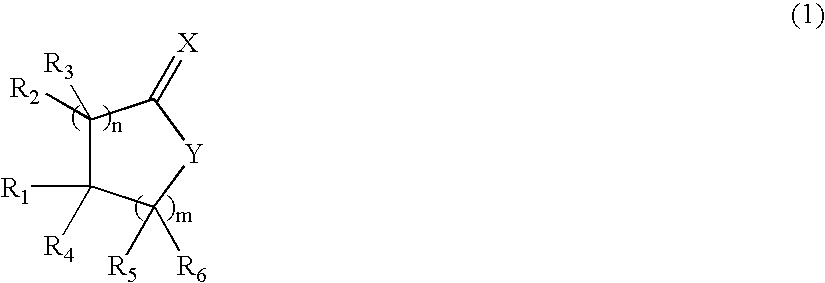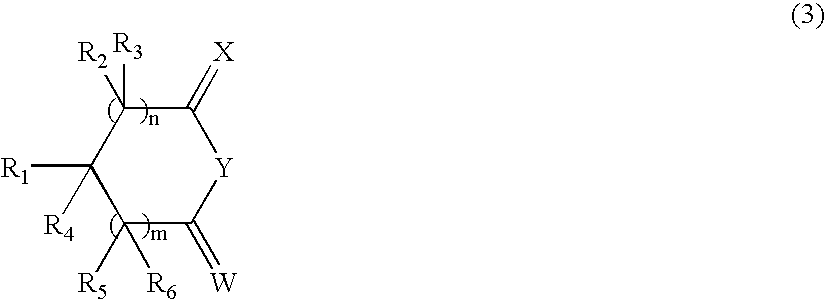Radiation curable compositions
a technology of compositions and curable materials, applied in the field of radiation curable compositions, can solve the problems of increasing the amount of photoinitiators, high cost of photoinitiators, etc., and achieve the effect of improving reactivity and photosensitivity
- Summary
- Abstract
- Description
- Claims
- Application Information
AI Technical Summary
Benefits of technology
Problems solved by technology
Method used
Image
Examples
examples 1-6
AND COMPARATIVE EXPERIMENTS A-O
[0173]Boltzmann average dipole moments of functional groups which have been attached to an acrylate group have been calculated. Examples 1-6 show functional groups, attached to an acrylate group, falling under the invention. Comparative experiments A-O show acrylates which are known in the art, which show a low Boltzmann average dipole moment and do not fall under the present invention.
[0174]Cure speeds of the monomers of examples 1-6 and comparative experiments have been measured; 1% Irgacure 184 (w / w) was dissolved in the monomer and the cure was monitored by RT-FTIR. The RT-FTIR measurement of Example 5 was carried out at 50° C., because the monomer of Example 5 is a solid at room temperature.
[0175]
dipole AM1rateExampleStructure(Debye(mol / l sec)13.8717.924.1217.934.54 17.5546.533 57.3838 (at 50° C.)64.6225.2Comparative experiments: Calculated Boltzman average Dipole moments (3.5 Debye and lower) and rates of pure monomers are given.
[0176]
Comparati...
example 7
[0179]1% Irgacure 184 was dissolved in a mixture of oxazolidone acrylate (a monomer with a high calculated dipole moment of D=5.3) and tetrahydrofurfuryl acrylate (a monomer with a low calculated dipole moment of D=2.05). The ratio of the two monomers has been changed in the series of experiments, thereby changing the calculated dipole moment of the mixture of the two monomers and the dielectric constant of the composition. The rates of polymerization were determined with the aid of RT-FTIR. The results are shown in the next table
[0180]
mixture (%)Dipole (Debye)rate (mol / l sec)10002.055.390102.355.7980202.667.4670302.979.7560403.2812.5230704.2717.2320804.6120.6310904.9522.7201005.327.29
[0181]This example 7 clearly shows the surprising effect of an increase of the rate of polymerization when using an increasing amount of monomers having a high dipole moment.
example 8
[0182]Example 8 shows the effect of the use of a nonreactive diluent (propylene carbonate, having a high calculated dipole moment of D=5) on the rate of polymerization;
[0183]1% Irgacure 184 was dissolved in a mixture of propylene carbonate (D=5) and tetrahydrofurfuryl acrylate (a monomer having a low calculated dipole moment of D=2.05). The rates were determined with RT-FTIR using a transmissision setup between two NaCl plates. Due to this change in setup the light intensity was reduced resulting in a lower maximum rate of polymerization for tetrahydrofurfuryl acrylate. The results are shown in the next table.
[0184]
Amount propylenecarbonate (% w / w)Dipole (debye)Rate (mol / l sec)02.053.17102.483.62202.864.26303.214.77
[0185]This example shows that addition of a nonreactive compound having a high dipole moment also enhances the rate of polymerization.
PUM
| Property | Measurement | Unit |
|---|---|---|
| dipole moment | aaaaa | aaaaa |
| Boltzmann average dipole moment | aaaaa | aaaaa |
| dipole moment | aaaaa | aaaaa |
Abstract
Description
Claims
Application Information
 Login to View More
Login to View More - R&D
- Intellectual Property
- Life Sciences
- Materials
- Tech Scout
- Unparalleled Data Quality
- Higher Quality Content
- 60% Fewer Hallucinations
Browse by: Latest US Patents, China's latest patents, Technical Efficacy Thesaurus, Application Domain, Technology Topic, Popular Technical Reports.
© 2025 PatSnap. All rights reserved.Legal|Privacy policy|Modern Slavery Act Transparency Statement|Sitemap|About US| Contact US: help@patsnap.com



